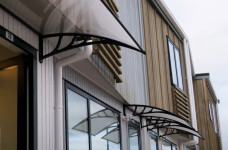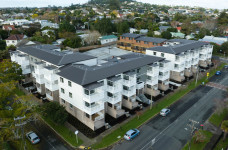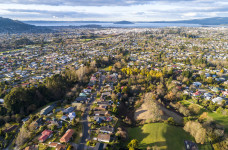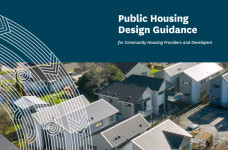Programme update
Social and transitional housing
Social housing provides families, whānau and individuals an affordable long-term home with security of tenure. Transitional housing provides short-term accommodation and wrap around support for people who are in urgent need of a place to stay.
About social housing
Social housing is a vital part of our social support system, providing families, individuals and whānau with a stable, affordable place to live. Social housing is owned or leased by Kāinga Ora - Homes and Community (Kāinga Ora) or Community Housing Providers (CHPs). It is targeted at households that are most in need of housing, who can’t access or sustain a tenancy in the private rental market for a range of reasons.
Please note, the terms ‘social’ and ‘public’ housing are used interchangeably.
Increasing the supply of social housing
Social housing is a vital part of New Zealand's social support system. The Government is committed to supporting the social housing system, and growing the Community Housing Sector, while investing in a fiscally sustainable way.
See data about public and transitional housing on the Housing Dashboard
Public Housing Plan
The Public Housing Plan will not be used to inform delivery of the new 1500 places from Budget 2024.
The Public Housing Plan provides delivery expectations, through to 30 June 2025, for the 6000 new places within Budget 2020 and the further 3000 new places within Budget 2023.
Budget 2024: New social housing places for Community Housing Providers
Budget 2024 allocates $140 million of new funding from the 2025/26 financial year for a total of 1500 new social housing places, over two financial years (2025/26 and 2026/27), to be operated by community housing providers (CHPs).
Of the 1500:
- around 500 places will be focused on maintaining momentum of social housing delivery and supporting government’s emergency housing reduction target in the near term
- most of the remaining 1000 places will be delivered through strategic partnerships with CHPs.
For the 500 places focused on maintaining momentum, government is taking a deliberate approach to investment in different locations.
Objectives will include:
- maximising value for money from Government investment
- reducing reliance on emergency housing and motel accommodation
- taking a balanced approach between achievability and building capability in historically under-served places.
Strategic partnerships to deliver homes
five new strategic partnerships will help to deliver most of the remaining 1,000 social homes.
This new approach to working with community housing providers, will allow them to develop homes with more flexibility, provided they continue to get value for money and address local housing needs. It’s also a way for us to build stronger and long-lasting relationships with community housing providers.
The first five community housing providers include:
- Accessible Properties New Zealand Limited
- Community of Refuge Trust (CORT)
- Emerge Aotearoa Housing Trust
- Te Āhuru Mōwai Limited Partnership
- The Salvation Army.
They were chosen based on their capacity to manage and deliver quality housing projects.
We’ll continue to develop this new approach over time, this could include establishing new strategic partnerships with more community housing providers as needed.
Priority locations
| Locations (based on territorial boundaries) | Type of home needed |
| Gisborne and the wider Tairāwhiti region | All types of homes required |
| Hamilton | All types of homes required |
| Napier (and Hastings) | Smaller homes required |
| Rotorua | Smaller homes required overall, but family homes needed in the short-term to reduce CEH (Contracted Emergency Housing) |
| Tauranga | All types of homes required |
| Projects in Auckland, Christchurch, and the Wellington metropolitan area, that support a reduction in emergency housing | Overall smaller homes required, but in Auckland and Christchurch family homes are needed in the short-term to reduce emergency housing use |
Public Housing Design Guidance for Community Housing Providers and Developers - update
HUD is working with Community Housing Providers (CHPs) and developers to increase the supply of new social housing.
HUD is often asked for support and guidance by the sector on design elements of new build developments. We have therefore worked with the sector and wider stakeholders to create Public Housing Design Guidance which help ensures all new homes are of good quality and fit for years of sustainable, comfortable living by their occupants.
Social housing residents do not have the same degree of choice as to what type of house they live in as those New Zealanders in the private rental market; this guide has therefore been created with the needs of a broad range of future residents at heart, and our belief that everyone deserves a good quality home.
The document provides guidance on design objectives and provide direction on the desired level of amenity HUD wants to promote in future long-term social housing which accesses the Income Related Rent Subsidy.
Many of the specific design details relate to a general, rather than targeted resident cohort, with there being an ability to discuss any proposed variations with the HUD – New Supply team early in the process. This document should not be interpreted as strictly imposed standards, rather a guidance document for a collaborative design process.
Download the Public Housing Design Guidance (PDF, 7.5 MB)
Partner with us
Te Tūāpapa Kura Kāinga, Ministry of Housing and Urban Development (HUD) is committed to working in partnership with CHPs on new housing opportunities. New social housing provided by CHPs will need to align with the Budget 2024 initiative of new social housing places for Community Housing Providers.
See what we look for in proposals. Read more about partnering with us
How to access social housing
People can access social housing when they are assessed by Ministry of Social Development as being in severe need of housing support and are placed on the Housing Register. Which is also referred to as the social housing waitlist.
The Housing Register shows applicants who are eligible for, but not currently in, social housing who are ready to be matched to a suitable property. The register helps us understand who needs social housing, where the housing is needed and what kind of housing is needed.
See the Public Housing Register on the Ministry of Social Development website(external link)
How social housing is funded
-
Income-related rent subsidy
The majority of social housing tenants pay an income-related rent determined by the Ministry of Social Development, with the amount generally set at 25 per cent of their net income.
HUD pays an income-related rent subsidy to Kāinga Ora – Homes and Communities and registered Community Housing Providers (CHPs) to cover the balance between the tenant’s rental payment and the market rent for the property. -
Operating Supplement
The Operating Supplement is one of the ways HUD provides funding to Kāinga Ora and CHPs to build more social housing places.
The Operating Supplement is a funding subsidy paid in addition to the Income-Related Rent Subsidy for eligible net new public houses to help enable new build supply. The Operating Supplement is calculated as a percentage of market rent up to a percentage cap.






